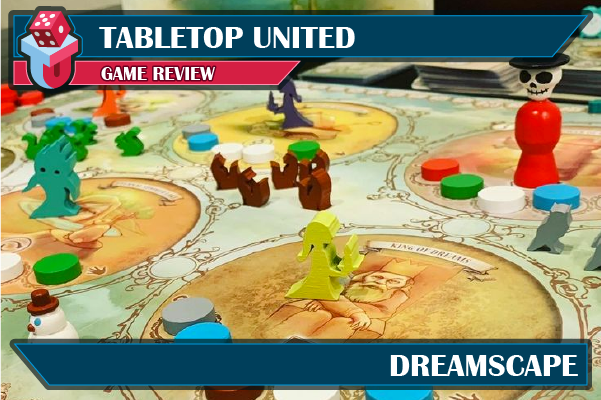
Dreamscape Review
Designer: David Ausloos & Pierre Steenebruggen
Artist: David Ausloos
Publisher: Sylex
Year Published: 2019
No. of Players: 1-4
Ages: 10+
Playing Time: 60-90 Minutes
Main Mechanic / Theme: Pattern Building & Action Points
Find more info on BoardGameGeek.com / Kickstarter
Overview:
"Dreamscape is a unique dream building game. Play as a dreamer collecting fragments of dreams in mysterious places like the lair of the Clockwork Golem. Create dreamlike landscapes with the help of these fragments, wander the paths, climb mountains and cross waterfalls." - Sylex (Publisher)
Gameplay and Mechanics:
Setting up the game is simple and quick. Select 4 common scoring objective tiles, shuffle the 3 personal scoring decks, fill the board with a number of discs (i.e. "shards") based on player count, randomly assign turn order tokens, and place your figure on that location number. Then, draw a number of basic "I" scoring cards based on your location number, select one to place face-up as your starting goal, and you're ready to rock and roll!
:strip_icc()/pic5534358.jpg)
Photo Credit - @a2b2c517 (BGG)
You start each turn with 4 action points that can be used for moving between adjacent locations, activating location bonuses (1x per round), and collecting shards. If you happen to possess a shard matching the color of shards in the left-most position (marked with a key icon) of adjacent location tracks, you may move freely to those locations without spending action points. This is referred to as "key movements" and happens to be the most interesting part of the action point allowance in my opinion. You may pick up a blue shard in your starting location just so you can move freely across a chain of 3 adjacent locations where blue shards just happen to occupy all 3 key positions in their relative tracks!
:strip_icc()/pic3679893.jpg)
Photo Credit - @CorumJha (BGG)
Personal scoring objectives are scored when patterns are met exactly as illustrated. Building patterns can be quite challenging, especially when you start to acquire multiple cards of varying difficulty levels. You can try to prioritize these patterns in a manner that leaves the greatest number of shards in place between scoring individual cards but some cards require you to build trees on a shard you'd rather not and so you are forced to collect more shards, spend actions to rearrange shards, and hope that you finish the patterns before the game ends. This may feel impossible with only 4 action points per round. However, possibly more critical than the specific pattern illustrated on these cards is the special bonus action that each card offers. This is where a secondary enginge building mechanism comes into play.
Each card offers an additional action that can be triggered by allocating a shard of any color from your reserve (i.e. hands, covering the designated action space on the card. By carefully selecting an effective combination of action types (e.g. add a random shard from the bag to your hand, move two shards from your board to your hand, etc.), you can easily extend the number of possible actions. Just be careful as incomplete cards are -5pt each at game end!
:strip_icc()/pic3655860.jpg) Photo Credit - @ausloosd (BGG)
Photo Credit - @ausloosd (BGG)
Theme, Artwork and Illustration, Graphic Design and Layout:
The illustrations included in this game are just beautiful. The graphic design is clean and concise. I wish that the shards came with some sort of stickers to dress them up as they are a bit bland against the artwork. Overall, I love the look and theme of Dreamscape. Having to construct a physical manifestation of various dreamscapes is such a clever way to integrate theme and design!
:strip_icc()/pic3784728.jpg)
Photo Credit - @CorumJha (BGG)
What Worked:
After a few plays, I really like the engine building element of this game. Each time you play, you're trying to get the most out of each round with the collection, placement, and repositioning of dream shards. As someone who enjoys spatial puzzles, this was a no brainer for me.
What Can Be Improved:
This game's primary player interaction stems from the collection of shards at each of the 6 locations. Similar to a game like Five Tribes, one player's movement and resource collection has a direct impact on your turn. Beyond that, you're simply trying to outscore your opponents in the 4 common objective "purpose" tiles. Having to wait for a player to finish their turn can be dreadful with the wrong group. Despite the potential for neverending turns, this game is relatively short. In fact, my wife has complained that Dreamscape actually feels too short to accomplish anything meaningful. While I initially agreed with her opinion, I think that reflects a lack of experience with the game. The more I've played, the better I've gotten at creating opportunities for bonus actions that allow me to do more each round. I would encourage anyone new to the game to reserve judgement until they've played 2 or 3 times as it does present a bit of a learning curve!
Final Thoughts:
Dreamscape is a wonderful achievement in art and design by David Ausloos & Pierre Steenebruggen. The theme is unique and engaging, the components are excellent, and the gameplay is deeply strategic. I have yet to dive into the numerous expansions released for this game but this something I look forward to in the future. I highly recommend Dreamscape for fans of games that incorporate variable action points, pattern/engine building, and spatial puzzles!

